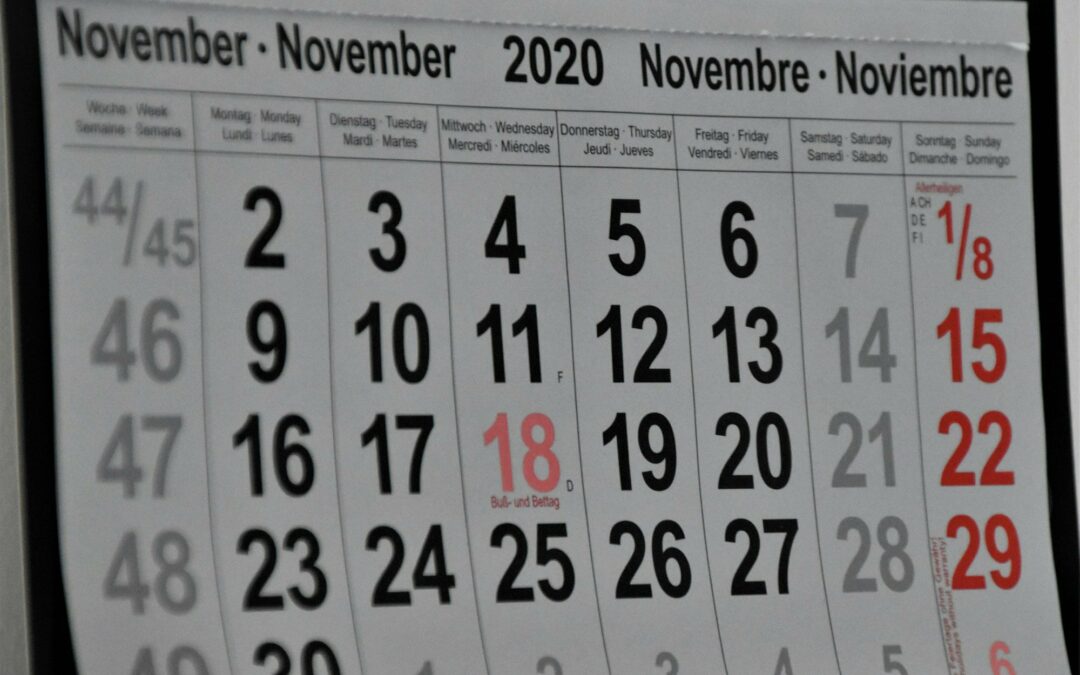At Virtalent, our growing team of Virtual Assistants dedicates on average 25% of their time managing client diaries. But what exactly does it take to manage a diary successfully?
In this article, we’ll explore effective strategies to confidently manage your busy schedule. Whether you’re managing your diary personally or relying on a Virtual Assistant with your schedule, these tips are designed to help.
What Exactly Is Diary Management?
As the name suggests, diary management is about managing your diary. However, don’t be misled, there’s more to it than meets the eye. It isn’t just about filling in your schedule but how you schedule strategically.
Productive diary management skills focus on:
- Scheduling appointments with buffer time to ensure a smoother day. Remembering to account for time needed to travel, pre-meeting preparation, and even a well-deserved lunch break.
- Schedules can change unexpectedly. It’s essential to ensure you know what’s in your diary, and of your commitments.
- Your time is valuable. Don’t let it be wasted by poorly-run meetings, or unnecessary events. Reserve your time only when the objective is clear and justifies your presence.
- Align your diary appointments with your natural working style. If you’re a morning person, consider scheduling breakfast meetings. Prefer a lighter end to your week? Keep Friday afternoons free. Whatever your preferences, your diary should work with your rhythm to improve productivity. Your diary should support you, not overwhelm you.
- Sync your diary with your inbox for seamless coordination. If a Virtual Assistant manages your diary, grant them access to your inbox. This simplifies diary management, reducing the risk of missed details. It also eliminates the need to keep updating your Virtual Assistant and streamlines your workflow.
- Ensure you’re comfortable with the technological tools you use. This could be a cloud-based solution like Google G Suite, Office 365, Outlook or another solution that suits your needs. Whatever it is, your diary can only be managed effectively if you can navigate it with ease.
Ultimately, the goal is to use your time effectively, making the most out of every moment. Achieving this requires a combination of technique and the right tools.

Practical Tips For Successful Scheduling
There are several ways to optimise your schedule with intentional diary management. By working smarter, not harder, these tips can become valuable, long-lasting habits that improve your productivity.
Colour Code Your Events
A busy diary can quickly become overwhelming. Our brains struggle to process large blocks of text and numbers, even when they’re organised into neat sections.
It sounds simple, but colour-coding your diary can help your brain. With colour, you can scan your weekly schedule in seconds instead of minutes. This colour-coded approach could include:
- Blue to represent 1:1 internal meetings – light blue for junior staff meetings and darker blue for those with senior team members.
- Yellow for team meetings – incorporating a range of similar colours (yellow, orange and red) to convey key information.
- Green for client-facing meetings.
You get the idea.
The concept is simple. Transform a wall of grey text into an organised planner that lets you quickly assess how your week is shaping up. This approach helps you plan and prioritise effectively.
Use Naming Conventions
But how should you label these colorful boxes? The goal is being able to find information at a glance. A list of names won’t provide much clarity. If all your diary entries are titled with variations of ‘Sam Wilson’ and ‘Bob Smith’, it can become confusing.
Instead, use a formula like [Event Type] – [Name] (Company) – [Extra Info]. This could look like:
*New partner meeting – Bob Smith (Smith inc) – Coffee @ Starbucks NW1.
The asterisk at the start signals that the meeting is off-site. This approach makes entries instantly understandable. In a fraction of the time we can see:
- The meeting is with a new partner to discuss potential collaboration. Avoid jargon like “existing” or “prospective”. Keep the language simple.
- It’s with Bob Smith from Smith Inc.
- Labelling the event as a coffee meeting signals its short or informal nature.
- You have indicated its location off-site.
If appropriate, consider sharing the event with Bob. First making sure it doesn’t contain anything you’d rather Bob didn’t read.
Alternatively, you can opt for a simpler format: [Their name] <> [Your name]. This keeps the entry title concise and avoids sharing too much information with other attendees.
Tailoring your diary management style depends on your role and scheduling needs. Experiment with different colour-coding systems and naming conventions. Over time, you’ll discover a pattern that works best for you.
Add Important Information To Calendar Entries
However, titles are often limited to very few characters. Making use of the event description space can be helpful. It’s an ideal place to reference any extra information you need, such as:
- The meeting’s agenda: use bullet points to help structure the meeting, ensuring all key topics are addressed.
- Pre-meeting preparation. Include a brief bio for each client you’re meeting, or a summary of their actions so far.
- Goals and objectives. Clearly define the purpose of the meeting and what you hope to achieve. Having a clear goal in mind will keep the appointment focused, reducing unnecessary noise.
- Practical information. This could include essential information like addresses, booking references, or important ticket information.
While it’s tempting to store this information in separate documents, notes, or even a folder in your inbox, it’s not the most convenient solution. Instead, keep everything in one place. The calendar you’re already checking before every appointment.

Be Clear on Time Zones
If you travel a lot, time zones are relevant. While your in-person meetings will naturally follow local time, you may still need to coordinate calls with your team back home. Without careful planning, time zone differences can get confusing.
This is where you decide to “stick or twist”. You can either keep your calendar set to your home time zone, regardless of where you are in the world or adjust it. Keeping it in your home time zone requires you to do a mental calculation of the meeting time to account for the local time difference. This can help you to stay aligned with in-person meetings.
Alternatively, you could update your calendar to the local time zone each time you travel. Just be mindful that any events you create are in this same time zone. This can make planning your week easier. As your diary entries are synced with your current location. Just remember to account for the time differences when scheduling calls with your team back home.
If you travel frequently, it’s often simpler to keep your calendar set to your home time zone. You can then calculate the time differences for local meetings.
Either approach can work, it just depends on your preferences and if your meetings are primarily local or calls back home. Once you understand your preferences, you can manage your diary effectively. Just be sure to stick to one method to avoid confusion.
Time Your Meetings Effectively
When scheduling meetings, the default can be to create 30-minute or one-hour blocks. However, this approach isn’t the most productive way to manage your diary.
Consider setting short internal meetings to 25 minutes. This keeps the meeting focused and allows you to stack your meetings with more ease. Now you have five minutes for the meeting to run late and head to your next one.
Likewise, longer meetings could be 50 minutes instead of one hour.
If you don’t need much prep time before meetings, stacking your diary is a game-changer. Instead of spreading three short meetings across 2.5 hours with a 30-minute break to stagger each, schedule them back-to-back lasting 25 minutes each. This way, you’ll fit all three meetings into 1.5 hours. Leaving you with an extra hour to work on something else.
Similarly, adopting other effective practices can enhance your workflow. Consider holding a daily ten-minute ‘stand up’ meeting with your team. This helps set priorities for the day and addresses any issues that may arise. This way, you avoid waiting for challenges to interrupt the day by tackling them earlier.
Taking a moment to reflect on how you manage your diary might seem simple but it can significantly influence your schedule and, ultimately, boost your productivity.

Set Handy Reminders
Make use of reminders. For example, Google Calendar lets you set multiple reminders on any event. Delivering convenient push notifications via email, phone, or your preferred browser.
If you’re feeling adventurous, why not try using Zapier to send SMS messages at a specific time. This text could include key details, preparation notes, or a meeting brief. Arriving 30 minutes before your meeting, it will keep you focused on the agenda you’ve set.
Reminders are a great way to ensure you avoid forgetting about a meeting, or the agenda you’ve planned. Some ideas to consider include:
- Set a diary reminder for the day before an important meeting. This allows you or your PA to confirm the appointment. This safeguard will ensure you’re not wasting your time getting to a meeting that’s been forgotten about.
- Set two reminders before a performance review: one 2 hours before and another 20 minutes prior. The first will help you prepare, and the second will prompt you to wrap up your work and arrive on time.
- Set an email reminder for the time you’re expecting a phone call. Avoid deleting or archiving the reminder email until you’ve sent a follow-up email to thank the recipient for their time. This safeguard ensures that any distractions post-meeting won’t stop you from always making the best impression.
One final tip: keep your calendar separate from your to-do list. While it might be easy to add reminders to your diary (perhaps as an all-day event), this can clutter your schedule. Making it hard to separate your appointments from any work you might need to do.
Instead, try using an app like Motion. These apps not only help you organise your tasks better but they also allow you to set due dates and reminders. This can be especially useful when you decide to keep tasks in your calendar. If you prefer, you can view your to-do list by date and focus on tasks due for a particular day. This means you can avoid cluttering your calendar with reminders while still ensuring you get timely notifications.
If you’ve enjoyed mastering diary management, you might be looking for more advice on how to stay organised. Take a look at Virtalent’s tips on managing email overload and using time-tracking tools.







